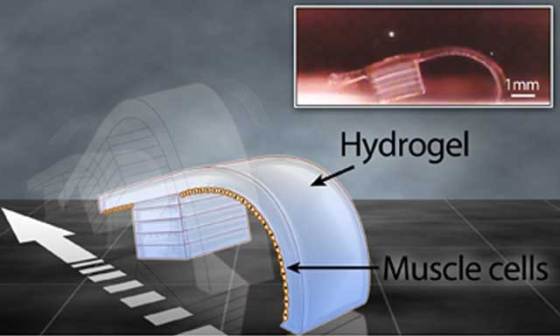Bio-bots – miniaturized walking biological machines
 Researchers from the University of Illinois are making tracks in synthetic biology by designing non-electronic biological machines. They used a 3D printer to combine hydrogel and heart cells to create bio-robots. These functional machines are biocompatible and soft, and they are able to move by themselves. Once perfected, these bio-bots could be altered and specialized for various applications in medicine, energy and environment technologies.
Researchers from the University of Illinois are making tracks in synthetic biology by designing non-electronic biological machines. They used a 3D printer to combine hydrogel and heart cells to create bio-robots. These functional machines are biocompatible and soft, and they are able to move by themselves. Once perfected, these bio-bots could be altered and specialized for various applications in medicine, energy and environment technologies.
“The idea is that, by being able to design with biological structures, we can harness the power of cells and nature to address challenges facing society”, said Rashid Bashir, an Abel Bliss Professor of Engineering. “As engineers, we’ve always built things with hard materials, materials that are very predictable. Yet there are a lot of applications where nature solves a problem in such an elegant way.”
A 3D printing method similar to one used in rapid prototyping is used to make the main body of the robot from hydrogel – a soft gelatin-like polymer. This approach enabled researchers to come up with a design with maximum speed and different configurations suitable for different applications, since they were able to quickly alter and test various versions of the design.
Bio-bots used to demonstrate their ability to walk are about 7 millimeters (a quarter of an inch) long, and the key to their locomotion is in asymmetry of their legs. Each bio-bot has one long and thin leg which rests on a stout supporting leg. The thin leg is covered with rat cardiac cells which pulse. When the heart cells beat, the long leg pulses and it moves the bio-bot forward.
“Our goal is to see if we can get this thing to move toward chemical gradients, so we could eventually design something that can look for a specific toxin and then try to neutralize it”, said Bashir, who also is a professor of electrical and computer engineering, and of bioengineering. “Now you can think about a sensor that’s moving and constantly sampling and doing something useful, in medicine and the environment. The applications could be many, depending on what cell types we use and where we want to go with it.”
University of Illinois researchers plan to enhance control and function, such as integrating neurons to direct motion or cells that respond to light, as well as discovering other variations of these bio-bots with different shapes, different numbers of legs, and abilities.
Once perfected, these robots could be used in medicine as medical sensors, for drug screening or chemical analysis, as well for toxin identification and cleanup. This can be achieved by a combination of this technology with cells which respond to certain stimuli in order to trigger detection or drug delivery.
For more information, you can red the paper published in the journal Scientific Reports: “Development of Miniaturized Walking Biological Machines” [2.7MB PDF].










Leave your response!